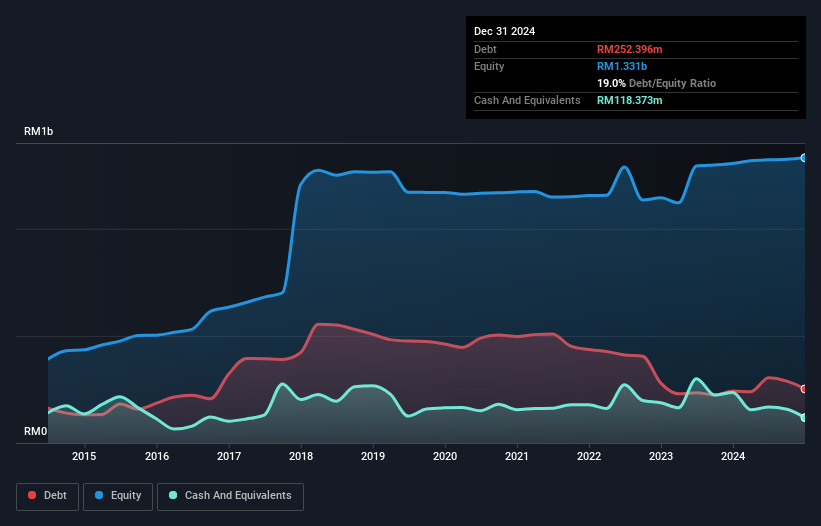Legendary fund manager Li Lu (who Charlie Munger backed) once said, 'The biggest investment risk is not the volatility of prices, but whether you will suffer a permanent loss of capital.' When we think about how risky a company is, we always like to look at its use of debt, since debt overload can lead to ruin. We can see that Titijaya Land Berhad (KLSE:TITIJYA) does use debt in its business. But is this debt a concern to shareholders?
When Is Debt Dangerous?
Debt and other liabilities become risky for a business when it cannot easily fulfill those obligations, either with free cash flow or by raising capital at an attractive price. Ultimately, if the company can't fulfill its legal obligations to repay debt, shareholders could walk away with nothing. However, a more usual (but still expensive) situation is where a company must dilute shareholders at a cheap share price simply to get debt under control. Of course, plenty of companies use debt to fund growth, without any negative consequences. The first step when considering a company's debt levels is to consider its cash and debt together.
What Is Titijaya Land Berhad's Debt?
The image below, which you can click on for greater detail, shows that at December 2024 Titijaya Land Berhad had debt of RM252.4m, up from RM242.5m in one year. However, because it has a cash reserve of RM118.4m, its net debt is less, at about RM134.0m.

How Strong Is Titijaya Land Berhad's Balance Sheet?
We can see from the most recent balance sheet that Titijaya Land Berhad had liabilities of RM574.6m falling due within a year, and liabilities of RM462.3m due beyond that. Offsetting these obligations, it had cash of RM118.4m as well as receivables valued at RM146.3m due within 12 months. So it has liabilities totalling RM772.2m more than its cash and near-term receivables, combined.
The deficiency here weighs heavily on the RM285.7m company itself, as if a child were struggling under the weight of an enormous back-pack full of books, his sports gear, and a trumpet. So we definitely think shareholders need to watch this one closely. After all, Titijaya Land Berhad would likely require a major re-capitalisation if it had to pay its creditors today. When analysing debt levels, the balance sheet is the obvious place to start. But you can't view debt in total isolation; since Titijaya Land Berhad will need earnings to service that debt. So if you're keen to discover more about its earnings, it might be worth checking out this graph of its long term earnings trend .
Check out our latest analysis for Titijaya Land Berhad
Over 12 months, Titijaya Land Berhad made a loss at the EBIT level, and saw its revenue drop to RM204m, which is a fall of 40%. That makes us nervous, to say the least.
Caveat Emptor
While Titijaya Land Berhad's falling revenue is about as heartwarming as a wet blanket, arguably its earnings before interest and tax (EBIT) loss is even less appealing. Indeed, it lost RM3.8m at the EBIT level. If you consider the significant liabilities mentioned above, we are extremely wary of this investment. That said, it is possible that the company will turn its fortunes around. But on the bright side the company actually produced a statutory profit of RM26m and free cash flow of RM11m. So there is arguably potential that the company is going to turn things around. When analysing debt levels, the balance sheet is the obvious place to start. But ultimately, every company can contain risks that exist outside of the balance sheet. For example - Titijaya Land Berhad has 2 warning signs we think you should be aware of.
If you're interested in investing in businesses that can grow profits without the burden of debt, then check out this free list of growing businesses that have net cash on the balance sheet.
Valuation is complex, but we're here to simplify it.
Discover if Titijaya Land Berhad might be undervalued or overvalued with our detailed analysis, featuring fair value estimates, potential risks, dividends, insider trades, and its financial condition.
Access Free AnalysisHave feedback on this article? Concerned about the content? Get in touch with us directly. Alternatively, email editorial-team (at) simplywallst.com.
This article by Simply Wall St is general in nature. We provide commentary based on historical data and analyst forecasts only using an unbiased methodology and our articles are not intended to be financial advice. It does not constitute a recommendation to buy or sell any stock, and does not take account of your objectives, or your financial situation. We aim to bring you long-term focused analysis driven by fundamental data. Note that our analysis may not factor in the latest price-sensitive company announcements or qualitative material. Simply Wall St has no position in any stocks mentioned.
About KLSE:TITIJYA
Titijaya Land Berhad
An investment holding company, engages in the property development activities in Malaysia.
Adequate balance sheet with very low risk.
Market Insights
Community Narratives




